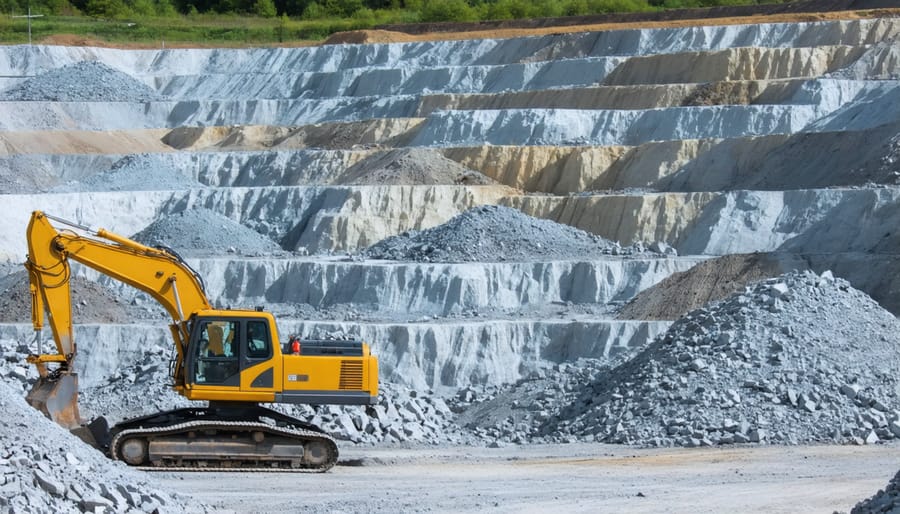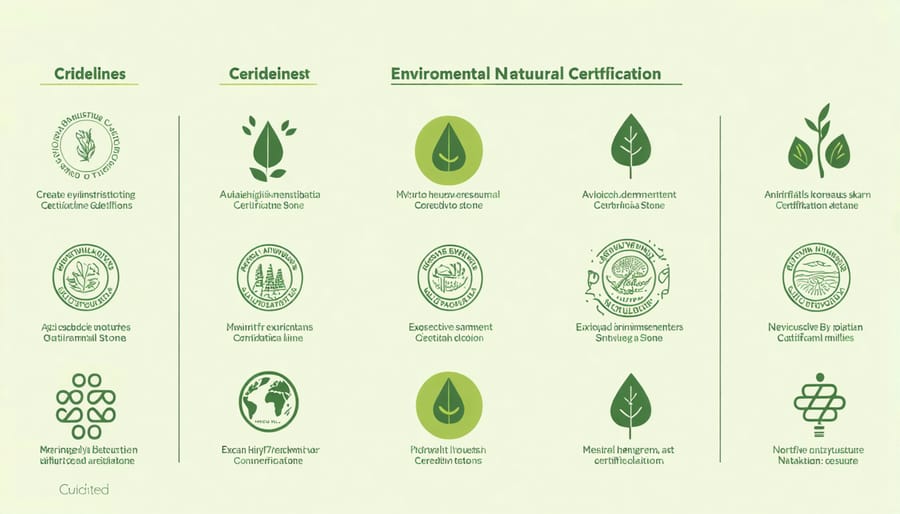Natural stone stands as a pivotal sustainable building material at the intersection of modern construction and environmental responsibility. Quarried directly from the Earth and requiring minimal processing, stone materials embody the principles of sustainable architecture through their durability, longevity, and zero VOC emissions. Unlike manufactured alternatives, natural stone delivers superior thermal mass properties that reduce building energy consumption while maintaining its aesthetic appeal for centuries without replacement. From the limestone facades of historic buildings to contemporary granite countertops, environmental stone solutions demonstrate how traditional building materials continue to meet today’s stringent sustainability standards. This remarkable resource not only elevates architectural design but also supports global initiatives for reducing construction’s environmental impact, making it an increasingly vital component in green building practices and LEED certification projects.
What Makes Stone Environmental?
Durability and Longevity
Natural stone stands as one of the most durable building materials available, with many historic structures serving as testament to its exceptional longevity. When properly installed and maintained, stone installations can last for centuries, far outlasting most modern building materials. This extended lifespan significantly reduces the environmental impact associated with material replacement and renovation cycles.
Unlike manufactured materials that may need replacement every 10-20 years, natural stone typically maintains its structural integrity and aesthetic appeal for generations. This durability translates directly into reduced resource consumption and lower environmental impact over time. Historic examples worldwide showcase stone’s resilience, from ancient Roman structures to medieval European castles that continue to stand after thousands of years.
The minimal maintenance requirements of stone further enhance its environmental credentials. Most stone surfaces require only basic cleaning and occasional sealing, eliminating the need for harsh chemicals or energy-intensive maintenance procedures. This combination of longevity and low maintenance makes stone a particularly sustainable choice for both interior and exterior applications, offering significant environmental advantages over its entire lifecycle.
Low Environmental Impact
Natural stone stands out as one of the most environmentally conscious building materials due to its remarkably low processing requirements. Unlike manufactured materials that demand extensive energy input and chemical processing, the environmental benefits of natural stone begin with its simple extraction process.
The journey from quarry to final product involves minimal industrial intervention. Stone is extracted through careful cutting and removal techniques that have been refined over centuries. Modern quarrying methods emphasize precision and efficiency, reducing waste and maximizing the usable material from each extraction site. This process requires significantly less energy compared to manufacturing artificial alternatives like concrete or synthetic materials.
Once extracted, stone typically only needs cutting, shaping, and polishing to prepare it for use. These processes use simple mechanical methods rather than chemical treatments or energy-intensive manufacturing. Water used in processing can be filtered and recycled, creating a closed-loop system that minimizes resource consumption.
The natural durability of stone also means it requires minimal maintenance throughout its lifetime. Unlike many building materials that need regular replacement or chemical treatments, stone maintains its integrity with basic cleaning and occasional resealing. This reduces the long-term environmental impact associated with maintenance and replacement cycles.
Furthermore, quarries can be rehabilitated after use, often becoming natural habitats or water features that benefit local ecosystems. Many modern quarrying operations integrate environmental management plans from the outset, ensuring responsible resource extraction while preserving surrounding landscapes.

Sustainable Quarrying Practices
Resource Management
Responsible resource management in the stone industry focuses on minimizing environmental impact while maximizing the utility of extracted materials. Modern quarrying operations employ advanced techniques such as diamond wire cutting and computer-guided extraction to reduce waste and optimize block recovery. These precision methods ensure that more usable stone is harvested from each quarry site, significantly reducing the environmental footprint of extraction activities.
Waste reduction strategies play a crucial role in sustainable stone production. Quarry operators now implement closed-loop water systems that recycle processing water, while stone fragments and offcuts are repurposed for aggregate, landscaping materials, or architectural details. Some innovative facilities crush and process stone waste into products like terrazzo flooring or engineered stone surfaces, ensuring nearly complete material utilization.
Quarry rehabilitation plans are developed before extraction begins, outlining how sites will be restored post-operation. These plans often include progressive rehabilitation, where sections of the quarry are restored while others remain active. This approach helps maintain local ecosystems and can even create new habitats for wildlife.
Technology now enables quarry operators to conduct detailed geological surveys, ensuring optimal site selection and reducing the likelihood of abandoned quarries due to poor stone quality or yield.
Land Reclamation
Quarry restoration represents a crucial aspect of environmental stewardship in the natural stone industry. After stone extraction, quarry operators implement comprehensive land reclamation plans that transform depleted sites into valuable ecological assets. These restoration projects often create diverse habitats, including wetlands, forests, and grasslands that support local wildlife populations.
Many restored quarries become thriving ecosystems, providing sanctuary for endangered species and creating new recreational spaces for local communities. For example, numerous former quarry sites across Europe and North America now serve as nature reserves, wildlife sanctuaries, and public parks. Some have been transformed into lakes and ponds, offering new aquatic habitats and supporting water management initiatives.
Modern quarry operations integrate restoration planning from the outset, ensuring minimal environmental impact throughout the site’s lifecycle. This includes carefully preserving topsoil, maintaining natural drainage patterns, and selecting native plant species for revegetation. Progressive rehabilitation techniques allow for concurrent extraction and restoration activities, reducing the overall environmental footprint.
The industry’s commitment to land reclamation demonstrates how stone extraction can coexist with environmental conservation, creating lasting positive impacts on local ecosystems while providing essential building materials.
Environmental Certifications
Natural stone’s environmental credentials can be validated through various internationally recognized certifications and standards. When choosing quality natural stone, these certifications serve as reliable indicators of sustainable practices and environmental responsibility.
The Natural Stone Council’s NSC 373 Certification stands as a comprehensive sustainability assessment program specifically designed for natural stone. This certification evaluates multiple criteria, including water usage, land reclamation practices, and corporate governance, ensuring that certified stone products meet rigorous environmental standards.
LEED (Leadership in Energy and Environmental Design) certification, while not specific to stone, plays a crucial role in the industry. Natural stone can contribute to LEED points in several categories, including Materials and Resources, Indoor Environmental Quality, and Innovation in Design. Stone products that contain recycled content or are sourced locally can earn additional credits.
The Declare Label, often called the “nutrition label” for building products, provides transparency about stone products’ origin, composition, and end-of-life options. This certification is particularly valuable for projects pursuing Living Building Challenge certification.
Green Squared Certification, though primarily associated with ceramic tiles, also applies to natural stone products. It evaluates environmental product characteristics, corporate governance, and innovation in manufacturing processes.
International Organization for Standardization (ISO) certifications, particularly ISO 14001 for environmental management systems, demonstrate a quarry or manufacturer’s commitment to environmental stewardship. These standards ensure consistent monitoring and improvement of environmental impacts throughout the production process.
Cradle to Cradle Certification examines natural stone products across five quality categories: material health, material reuse, renewable energy use, water stewardship, and social fairness. This holistic approach ensures that certified stone products meet comprehensive sustainability criteria throughout their lifecycle.
These certifications not only validate environmental claims but also provide architects, designers, and consumers with reliable metrics for comparing different stone products and manufacturers. When specified properly, certified stone products can contribute significantly to sustainable building practices while maintaining their timeless aesthetic appeal.


Applications in Green Building
Energy Efficiency
Natural stone stands out as a remarkable material for enhancing building energy efficiency, making it one of the most significant benefits of using natural stone in construction. Its high thermal mass allows it to absorb, store, and gradually release heat, creating a natural temperature regulation system within buildings.
During summer months, stone walls and flooring absorb excess heat during the day, helping maintain cooler indoor temperatures. At night, this stored heat dissipates, reducing the need for artificial cooling. In winter, the process reverses, with stone retaining warmth from heating systems or sunlight and releasing it slowly throughout colder periods.
This thermal performance can significantly reduce HVAC energy consumption, with studies showing potential energy savings of 10-30% in buildings utilizing natural stone elements effectively. Stone’s durability also means these energy-saving benefits continue throughout the material’s lifetime, which can span centuries.
When incorporated into building facades, stone cladding creates an additional insulating layer that further enhances energy efficiency. Light-colored stone varieties can also reflect solar radiation, reducing heat gain in warm climates. This natural temperature regulation not only decreases energy costs but also contributes to a more comfortable and sustainable living environment.
LEED Points
Natural stone can significantly contribute to achieving LEED (Leadership in Energy and Environmental Design) certification points across multiple categories. Buildings incorporating natural stone can earn credits in Materials and Resources (MR) by using locally sourced stone, which reduces transportation emissions and supports regional economies. Projects can earn additional points when stone is extracted and manufactured within 500 miles of the construction site.
The Building Product Disclosure and Environmental Performance category offers opportunities for LEED points through Environmental Product Declarations (EPDs) and material ingredient reporting. Many stone suppliers now provide detailed documentation of their products’ environmental impacts, making it easier for projects to earn these credits.
Natural stone’s durability and longevity contribute to the Building Life-Cycle Impact Reduction credit, as it typically outlasts most other building materials and requires minimal replacement over time. Its thermal mass properties can also help earn points in the Energy and Atmosphere category by reducing heating and cooling loads.
Projects can earn Innovation credits through creative use of stone in sustainable design strategies, such as implementing passive solar design or creating green walls with stone elements. Additionally, stone’s low VOC emissions and natural composition contribute to Indoor Environmental Quality credits, ensuring healthy interior spaces.
When properly documented, recycled or salvaged stone can qualify for Construction Waste Management credits, particularly in renovation projects where existing stone is preserved or repurposed.
Natural stone stands as a testament to sustainable construction practices, offering enduring environmental benefits that align with modern green building initiatives. Its inherent durability ensures structures last for generations, reducing the need for frequent replacements and minimizing waste. The minimal processing requirements and local sourcing opportunities further decrease its carbon footprint compared to manufactured materials.
Looking ahead, the natural stone industry continues to evolve with improved quarrying techniques, more efficient processing methods, and innovative recycling programs. The growing emphasis on environmental certifications and sustainable practices is driving positive change throughout the supply chain. As architects and designers increasingly prioritize eco-friendly materials, natural stone’s role in sustainable construction is expected to expand.
The future outlook for environmental stone is promising, with new technologies enabling better resource utilization and reduced waste. From water recycling systems in quarries to advanced cutting techniques that maximize material usage, the industry is embracing practices that enhance its environmental credentials. This commitment to sustainability, combined with stone’s timeless appeal and natural durability, positions it as a key material for environmentally conscious construction in the years to come.










